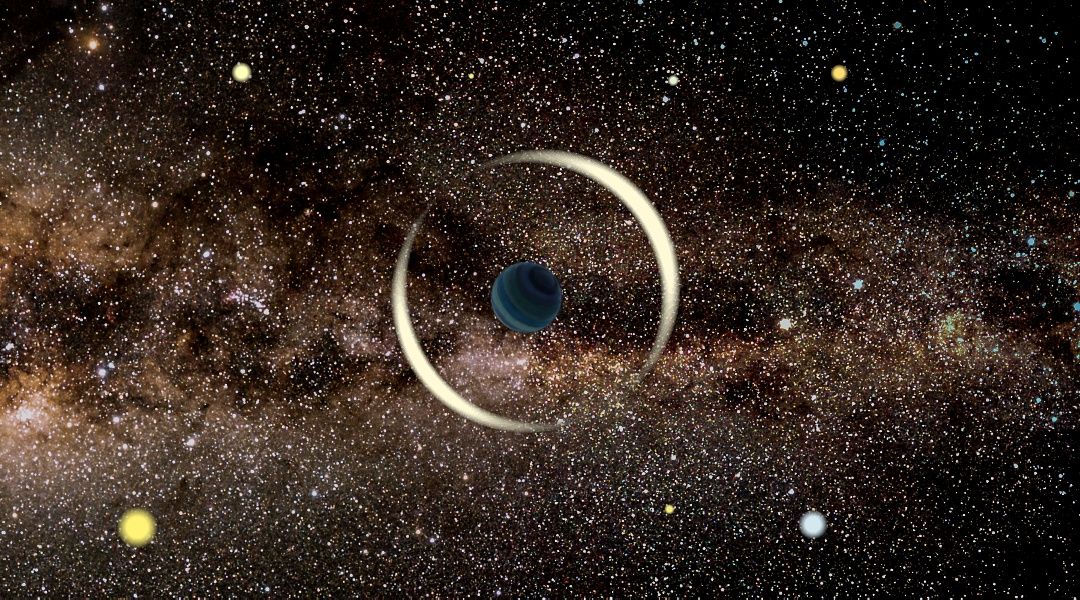
Astronomers have spotted the smallest "rogue planet" candidate yet known, a world possibly smaller than Earth that apparently cruises through our Milky Way galaxy unattached to a star.
The potential exoplanet has a mass that's somewhere between that of the Earth and Mars, which is just 10% as hefty as our world. If confirmed, the discovery would be a big milestone in the study of rogue planets, which are thought to be incredibly abundant throughout the galaxy and beyond but are very difficult to detect.
"Our discovery demonstrates that low-mass free-floating planets can be detected and characterized using ground-based telescopes," Andrzej Udalski, co-author of a new study announcing the find and principal investigator of the Optical Gravitational Lensing Experiment (OGLE) project, said in a statement.
Related: The strangest alien planets (gallery)
Common but hard to see
Astronomers have discovered more than 4,000 confirmed exoplanets to date. Most of them have been found using the "transit method," which notes the brightness dips caused when a world crosses its host star's face from an observer's perspective, or the "radial velocity method," which spots stellar movements induced by a planet's gravitational pull.
Both of these techniques depend on the existence of a host star, so they cannot be used to hunt for rogue worlds. But another planet-hunting technique can do the job — "gravitational microlensing," which involves watching foreground objects pass in front of distant background stars. When this happens, the closer body can act as a gravitational lens, bending and magnifying the star's light in ways that can reveal the foreground object's mass and other characteristics.
"Chances of observing microlensing [events] are extremely slim because three objects — [light] source, lens and observer — must be nearly perfectly aligned," study lead author Przemek Mroz, a postdoctoral researcher at the California Institute of Technology in Pasadena, said in the same statement. "If we observed only one source star, we would have to wait almost a million years to see the source being microlensed."
Related: 7 ways to find alien planets
But planet hunters such as Mroz don't observe the heavens one star at a time. In the new study, for example, Mroz and his colleagues analyzed data gathered by OGLE. This project, led by the University of Warsaw in Poland, uses a 1.3-meter telescope at Las Campanas Observatory in Chile to monitor millions of stars near the Milky Way's center on every clear night.
The researchers pulled a very interesting signal out of the OGLE observations — an event called OGLE-2016-BLG-1928, which at 42 minutes long is the shortest microlensing event ever detected. The team further characterized the event using data collected by the Korea Microlensing Telescope Network, which operates telescopes in Chile, Australia and South Africa.
"When we first spotted this event, it was clear that it must have been caused by an extremely tiny object," co-author Radoslaw Poleski, of the Astronomical Observatory of the University of Warsaw, said in the same statement.
The team's calculations suggest that the lensing body has a mass between that of Mars and Earth, and is probably closer in heft to the Red Planet than to our own world. And the OGLE-2016-BLG-1928 candidate is likely zooming through deep space all by its lonesome.
"If the lens were orbiting a star, we would detect its presence in the light curve of the event," Poleski said. "We can rule out the planet having a star within about 8 astronomical units."
One astronomical unit, or AU, is the average distance from Earth to the sun — about 93 million miles (150 million kilometers). In our own solar system, an object at 8 AU would circle the sun between Jupiter and Saturn — a strange place for a small, rocky planet to exist.
The new study was published online today (Oct. 29) in Astrophysical Journal Letters. You can read a preprint of it for free at arXiv.org.
Related: Mysterious 'Planet Nine' may be a captured rogue world
Booted from home
Astronomers have discovered only a handful of confirmed rogue planets to date. But this small number suggests a large population, scientists say, given how difficult these exotic worlds are to detect.
Astronomers think that most rogue planets were born in the "normal" way, coalescing from the gas and dust spinning around a newly formed star. But these worlds were eventually booted out of their native systems by gravitational interactions with other bodies, especially their gas-giant siblings.
Theory suggests that most rogues ejected in this way are rocky worlds with masses 30% to 100% that of Earth, Mroz and his colleagues note in the new study. So the OGLE-2016-BLG-1928 candidate may well be fairly representative of the teeming but elusive rogue population.
We could soon start getting a much better handle on that population. For instance, NASA's Nancy Grace Roman Space Telescope, which is scheduled to launch in the mid-2020s, will conduct a large microlensing survey, among other science tasks. That survey will likely find about 250 rogue planets, including 60 or so that are Earth-mass or lighter, a recent study found.
Mike Wall is the author of "Out There" (Grand Central Publishing, 2018; illustrated by Karl Tate), a book about the search for alien life. Follow him on Twitter @michaeldwall. Follow us on Twitter @Spacedotcom or Facebook.
Science - Latest - Google News
October 29, 2020 at 11:08PM
https://ift.tt/2HLuwgM
Tiny rogue planet is the smallest free-floating exoplanet candidate yet - Space.com
Science - Latest - Google News
https://ift.tt/2Kb7H4e
https://ift.tt/3ceUkwc
Bagikan Berita Ini

















0 Response to "Tiny rogue planet is the smallest free-floating exoplanet candidate yet - Space.com"
Post a Comment